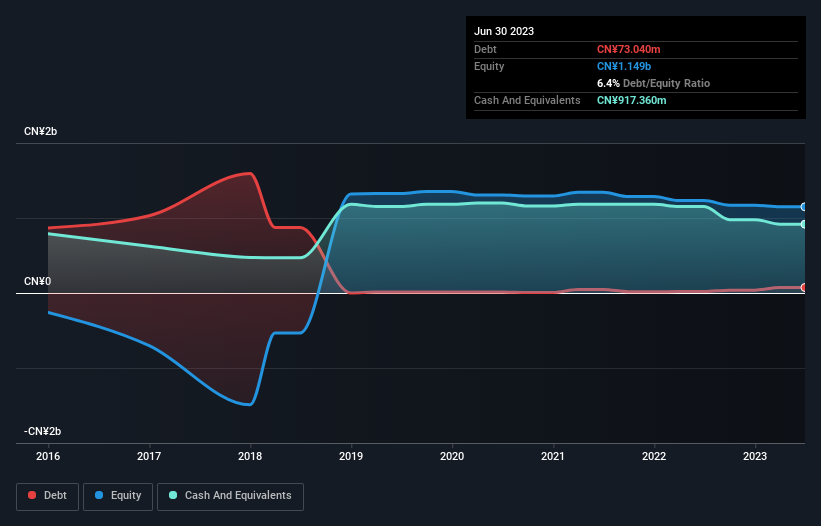Howard Marks put it nicely when he said that, rather than worrying about share price volatility, 'The possibility of permanent loss is the risk I worry about... and every practical investor I know worries about.' When we think about how risky a company is, we always like to look at its use of debt, since debt overload can lead to ruin. Importantly, Qeeka Home (Cayman) Inc. (HKG:1739) does carry debt. But the real question is whether this debt is making the company risky.
When Is Debt Dangerous?
Debt and other liabilities become risky for a business when it cannot easily fulfill those obligations, either with free cash flow or by raising capital at an attractive price. In the worst case scenario, a company can go bankrupt if it cannot pay its creditors. However, a more common (but still painful) scenario is that it has to raise new equity capital at a low price, thus permanently diluting shareholders. By replacing dilution, though, debt can be an extremely good tool for businesses that need capital to invest in growth at high rates of return. When we examine debt levels, we first consider both cash and debt levels, together.
Check out our latest analysis for Qeeka Home (Cayman)
How Much Debt Does Qeeka Home (Cayman) Carry?
The image below, which you can click on for greater detail, shows that at June 2023 Qeeka Home (Cayman) had debt of CN¥73.0m, up from CN¥19.5m in one year. But on the other hand it also has CN¥917.4m in cash, leading to a CN¥844.3m net cash position.

A Look At Qeeka Home (Cayman)'s Liabilities
Zooming in on the latest balance sheet data, we can see that Qeeka Home (Cayman) had liabilities of CN¥667.4m due within 12 months and liabilities of CN¥23.0m due beyond that. Offsetting this, it had CN¥917.4m in cash and CN¥320.9m in receivables that were due within 12 months. So it actually has CN¥547.8m more liquid assets than total liabilities.
This excess liquidity is a great indication that Qeeka Home (Cayman)'s balance sheet is almost as strong as Fort Knox. On this view, lenders should feel as safe as the beloved of a black-belt karate master. Simply put, the fact that Qeeka Home (Cayman) has more cash than debt is arguably a good indication that it can manage its debt safely. The balance sheet is clearly the area to focus on when you are analysing debt. But you can't view debt in total isolation; since Qeeka Home (Cayman) will need earnings to service that debt. So when considering debt, it's definitely worth looking at the earnings trend. Click here for an interactive snapshot.
Over 12 months, Qeeka Home (Cayman) made a loss at the EBIT level, and saw its revenue drop to CN¥941m, which is a fall of 7.2%. That's not what we would hope to see.
So How Risky Is Qeeka Home (Cayman)?
We have no doubt that loss making companies are, in general, riskier than profitable ones. And we do note that Qeeka Home (Cayman) had an earnings before interest and tax (EBIT) loss, over the last year. And over the same period it saw negative free cash outflow of CN¥131m and booked a CN¥85m accounting loss. Given it only has net cash of CN¥844.3m, the company may need to raise more capital if it doesn't reach break-even soon. Overall, its balance sheet doesn't seem overly risky, at the moment, but we're always cautious until we see the positive free cash flow. The balance sheet is clearly the area to focus on when you are analysing debt. However, not all investment risk resides within the balance sheet - far from it. Be aware that Qeeka Home (Cayman) is showing 4 warning signs in our investment analysis , and 2 of those don't sit too well with us...
At the end of the day, it's often better to focus on companies that are free from net debt. You can access our special list of such companies (all with a track record of profit growth). It's free.
Valuation is complex, but we're here to simplify it.
Discover if Qeeka Home (Cayman) might be undervalued or overvalued with our detailed analysis, featuring fair value estimates, potential risks, dividends, insider trades, and its financial condition.
Access Free AnalysisHave feedback on this article? Concerned about the content? Get in touch with us directly. Alternatively, email editorial-team (at) simplywallst.com.
This article by Simply Wall St is general in nature. We provide commentary based on historical data and analyst forecasts only using an unbiased methodology and our articles are not intended to be financial advice. It does not constitute a recommendation to buy or sell any stock, and does not take account of your objectives, or your financial situation. We aim to bring you long-term focused analysis driven by fundamental data. Note that our analysis may not factor in the latest price-sensitive company announcements or qualitative material. Simply Wall St has no position in any stocks mentioned.
About SEHK:1739
Qeeka Home (Cayman)
Operates online interior design and construction platform in the People’s Republic of China.
Excellent balance sheet with slight risk.
Market Insights
Community Narratives



